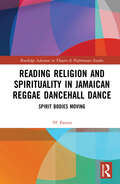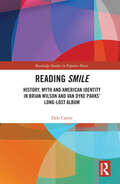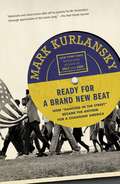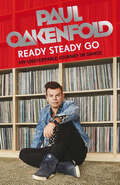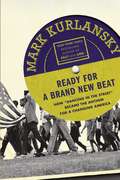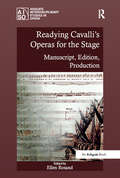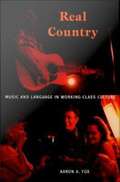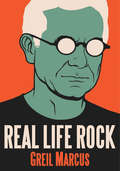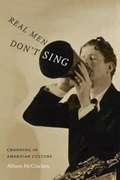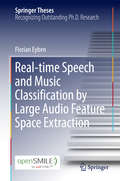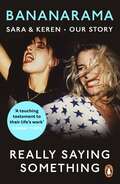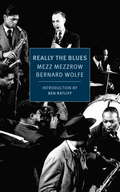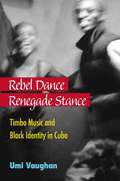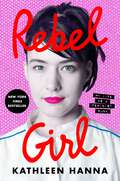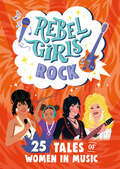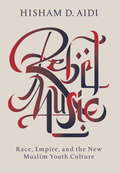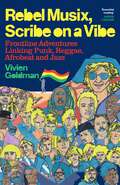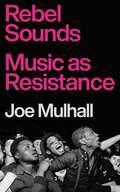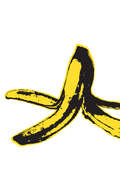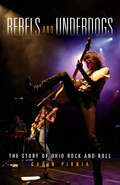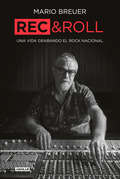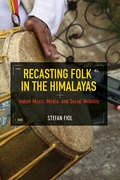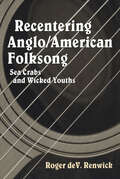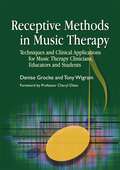- Table View
- List View
Reading Religion and Spirituality in Jamaican Reggae Dancehall Dance: Spirit Bodies Moving (Routledge Advances in Theatre & Performance Studies)
by 'H' PattenThis book explores the genealogy of Jamaican dancehall while questioning whether dancehall has a spiritual underscoring, foregrounding dance, and cultural expression. This study identifies the performance and performative (behavioural actions) that may be considered as representing spiritual ritual practices within the reggae/dancehall dance phenomenon. It does so by juxtaposing reggae/dancehall against Jamaican African/neo-African spiritual practices such as Jonkonnu masquerade, Revivalism and Kumina, alongside Christianity and post-modern holistic spiritual approaches. This book will be of great interest to students and scholars in performance studies, popular culture, music, theology, cultural studies, Jamaican/Caribbean culture, and dance specialists.
Reading Smile: History, Myth and American Identity in Brian Wilson and Van Dyke Parks’ Long-Lost Album (Routledge Studies in Popular Music)
by Dale CarterFirst conceived in 1966 but only completed in 2004, Brian Wilson Presents Smile has been called "the best-known unreleased album in pop music history" and "an American Sergeant Pepper." Reading Smile offers a close analysis of the recording in its social, cultural and historical contexts. It focuses in particular on the finished work’s subject matter as embodied in Van Dyke Parks’ contentious yet little understood lyrics, with their low-resolution, highly allusive portrayals of western expansion’s archetypes, from Plymouth Rock, Massachusetts to Diamond Head, Hawaii. Documenting their multiple references and connotations, it argues that their invocations of national self-definition are part of a carefully crafted vision of American identity, society and culture both in tune and at odds with the times. Critical of the republic’s past practices but convinced that its ideals, values and myths still provided resources to redeem it, the recording is interpreted as a creative musical milestone, an enduring product of its volatile, radical, countercultural times, and an American pop art classic. Of particular relevance to American Studies and popular culture scholars, Reading Smile will also appeal to those interested in 1960s popular music, not least to fans of Brian Wilson, Van Dyke Parks and the Beach Boys.
Ready For a Brand New Beat
by Mark KurlanskyCan a song change a nation? In 1964, Marvin Gaye, record producer William "Mickey" Stevenson, and Motown songwriter Ivy Jo Hunter wrote "Dancing in the Street." The song was recorded at Motown's Hitsville USA Studio by Martha and the Vandellas, with lead singer Martha Reeves arranging her own vocals. Released on July 31, the song was supposed to be an upbeat dance recording--a precursor to disco, and a song about the joyousness of dance. But events overtook it, and the song became one of the icons of American pop culture. The Beatles had landed in the U.S. in early 1964. By the summer, the sixties were in full swing. The summer of 1964 was the Mississippi Freedom Summer, the Berkeley Free Speech Movement, the beginning of the Vietnam War, the passage of the Civil Rights Act, and the lead-up to a dramatic election. As the country grew more radicalized in those few months, "Dancing in the Street" gained currency as an activist anthem. The song took on new meanings, multiple meanings, for many different groups that were all changing as the country changed. Told by the writer who is legendary for finding the big story in unlikely places, Ready for a Brand New Beat chronicles that extraordinary summer of 1964 and showcases the momentous role that a simple song about dancing played in history.
Ready Steady Go: My Unstoppable Journey in Dance
by Paul Oakenfold"A wild ride of a life... Oakenfold's story is extraordinary" - The Times Follow Paul Oakenfold – world-renowned DJ and dance music pioneer – as he tells his incredible story of a phenomenal career at the beating heart of dance.Paul's journey takes him from a musical baptism in 1980s New York and underground club nights in London to running a seminal dance record label and a legendary trip to Ibiza that introduced him to trance and changed the face of dance music forever.A breathless adventure through music, Ready Steady Go is a story of dance, trance, excess and success.
Ready for a Brand New Beat: How "Dancing in the Street" Became the Anthem for a Changing America
by Mark KurlanskyCan a song change a nation? In 1964, Marvin Gaye, record producer William "Mickey" Stevenson, and Motown songwriter Ivy Jo Hunter wrote "Dancing in the Street. " The song was recorded at Motown's Hitsville USA Studio by Martha and the Vandellas, with lead singer Martha Reeves arranging her own vocals. Released on July 31, the song was supposed to be an upbeat dance recording--a precursor to disco, and a song about the joyousness of dance. But events overtook it, and the song became one of the icons of American pop culture. The Beatles had landed in the U. S. in early 1964. By the summer, the sixties were in full swing. The summer of 1964 was the Mississippi Freedom Summer, the Berkeley Free Speech Movement, the beginning of the Vietnam War, the passage of the Civil Rights Act, and the lead-up to a dramatic election. As the country grew more radicalized in those few months, "Dancing in the Street" gained currency as an activist anthem. The song took on new meanings, multiple meanings, for many different groups that were all changing as the country changed. Told by the writer who is legendary for finding the big story in unlikely places,Ready for a Brand New Beatchronicles that extraordinary summer of 1964 and showcases the momentous role that a simple song about dancing played in history.
Readying Cavalli's Operas for the Stage: Manuscript, Edition, Production (Ashgate Interdisciplinary Studies In Opera Ser.)
by Ellen RosandAfter more than three centuries of silence, the voice of Francesco Cavalli is being heard loud and clear on the operatic stages of the world. The coincidence of productions at La Scala (Milan) and Covent Garden (London) in the same month (September 2008) of two different operas signals a new stage in the recovery of these extraordinary works, confined until now to special venues committed to 'early music'-opera festivals, conservatory, and university productions. The works of the composer who is credited with having invented the genre of opera as we know it are finally enjoying a renaissance. A new edition of Cavalli's twenty-eight operas is in preparation, and the composer and his works are at the center of a great deal of new scholarship ranging from the study of sources and production issues to the cultural context of opera of this period. In the face of such burgeoning interest, this collection of essays considers the Cavalli revival from various points of view. In particular, it explores the multiple issues involved in the transformation of an operatic manuscript into a performance. Although focused on the works of Cavalli, much of this material can transfer easily to other operatic repertoires.Following an introductory part, reflecting back on four decades of Cavalli performances by some of the conductors responsible for the revival of interest in the composer, the collection is divided into four further parts: The Manuscript Scores, Giasone: Production and Interpretation, Making Librettos, and Cavalli Beyond Venice.
Real Country: Music and Language in Working-Class Culture
by Aaron A. FoxIn Lockhart, Texas, a rural working-class town just south of Austin, country music is a way of life. Conversation slips easily into song, and the songs are full of conversation. Anthropologist and musician Aaron A. Fox spent years in Lockhart making research notes, music, and friends. In Real Country, he provides an intimate, in-depth ethnography of the community and its music. Showing that country music is deeply embedded in the textures of working-class life, Fox argues that it is the cultural and intellectual property of working-class people and not only of the Nashville-based music industry or the stars whose lives figure so prominently in popular and scholarly writing about the genre. Fox spent hundreds of hours observing, recording, and participating in talk and music-making in homes, beer joints, and garage jam sessions. He renders the everyday life of Lockhart's working-class community in detail, right down to the ice cold beer, the battered guitars, and the technical skills of such local musical legends as Randy Meyer and Larry "Hoppy" Hopkins. Throughout, Fox focuses on the human voice. His analyses of conversations, interviews, songs, and vocal techniques show how feeling and experience are expressed, and how local understandings of place, memory, musical aesthetics, working-class social history, race, and gender are shared. In Real Country, working-class Texans re-imagine their past and give voice to the struggles and satisfactions of their lives in the present through music.
Real Life Rock
by Greil MarcusFor nearly thirty years, Greil Marcus has written a remarkable column called "Real Life Rock Top Ten. " It has been a laboratory where he has fearlessly explored and wittily dissected an enormous variety of cultural artifacts, from songs to books to movies to advertisements. Taken together, his musings, reflections, and sallies amount to a subtle and implicit theory of how cultural objects fall through time and circumstance and often deliver unintended consequences, both in the present and in the future. Real Life Rock reveals the critic in full: direct, erudite, funny, fierce, vivid, uninhibited, and possessing an unerring instinct for art and fraud. The result is an indispensable volume packed with startling arguments and casual brilliance.
Real Men Don't Sing: Crooning in American Culture
by Allison MccrackenThe crooner Rudy Vallée's soft, intimate, and sensual vocal delivery simultaneously captivated millions of adoring fans and drew harsh criticism from those threatened by his sensitive masculinity. Although Vallée and other crooners reflected the gender fluidity of late-1920s popular culture, their challenge to the Depression era's more conservative masculine norms led cultural authorities to stigmatize them as gender and sexual deviants. In Real Men Don't Sing Allison McCracken outlines crooning's history from its origins in minstrelsy through its development as the microphone sound most associated with white recording artists, band singers, and radio stars. She charts early crooners' rise and fall between 1925 and 1934, contrasting Rudy Vallée with Bing Crosby to demonstrate how attempts to contain crooners created and dictated standards of white masculinity for male singers. Unlike Vallée, Crosby survived the crooner backlash by adapting his voice and persona to adhere to white middle-class masculine norms. The effects of these norms are felt to this day, as critics continue to question the masculinity of youthful, romantic white male singers. Crooners, McCracken shows, not only were the first pop stars: their short-lived yet massive popularity fundamentally changed American culture.
Real-time Speech and Music Classification by Large Audio Feature Space Extraction
by Florian EybenThis book reports on an outstanding thesis thathas significantly advanced the state-of-the-art in the automated analysis andclassification of speech and music. Itdefines several standard acoustic parameter sets and describes theirimplementation in a novel, open-source, audio analysis framework calledopenSMILE, which has been accepted and intensively used worldwide. The bookoffers extensive descriptions of key methods for the automatic classificationof speech and music signals in real-life conditions and reports on theevaluation of the framework developed and the acoustic parameter sets that wereselected. It is not only intended as a manual for openSMILE users, but also andprimarily as a guide and source of inspiration for students and scientists involvedin the design of speech and music analysis methods that can robustly handlereal-life conditions.
Really Saying Something: Sara & Keren – Our Bananarama Story
by Sara Dallin Keren Woodward______________________________________'Engaging, entertaining, brilliantly recounted' Mirror 'Captivating . . . an incredible story' i paper__________________________________MUSIC, FAME AND A LIFELONG FRIENDSHIPSara Dallin and Keren Woodward met in the school playground when they were four. They went on to become international stars and inspired a generation with their music, DIY-style and trailblazing attitudes.Told with humour and authenticity, and filled with never-before-seen photos, Really Saying Something takes us behind the scenes of their early days, the world tours, party games with George Michael, a close friendship with Prodigy's Keith Flint, and hanging out with Andy Warhol in New York.This is a celebration of a life-affirming friendship, with an unbeatable soundtrack.__________________________________'Like something from a movie' Dermot O'Leary'A brilliant autobiography' Martin Kemp'A blast' Metro'What a nostalgia-fest' Kate Thornton
Really the Blues
by Bernard Wolfe Ben Ratliff Mezz MezzrowMezz Mezzrow was a Jewish boy from the slums of Chicago who learned to play the clarinet in reform school and pursued a life in music and a life of crime. He moved from Chicago to New Orleans to New York, working in brothels and bars, bootlegging, dealing drugs, getting hooked, doing time, producing records, and playing with the greats, among them Louis Armstrong, Bix Beiderbecke, and Fats Waller. Really the Blues, the jive-talking memoir that Mezzrow wrote at the insistence of, and with the help of, the novelist Bernard Wolfe, is the story of an unusual and unusually American life, and a picture of a man who moved freely across racial boundaries when few could or did, "the odyssey of an individualist. . . the saga of a guy who wanted to make friends in a jungle were everyone was too busy making money."
Rebel Dance, Renegade Stance: Timba Music and Black Identity in Cuba
by Umi VaughanRebel Dance, Renegade Stance shows how community music-makers and dancers take in all that is around them socially and globally, and publicly and bodily unfold their memories, sentiments, and raw responses within open spaces designated or commandeered for local popular dance. Umi Vaughan, an African American anthropologist, musician, dancer, and photographer "plantao" in Cuba—planted, living like a Cuban—reveals a rarely discussed perspective on contemporary Cuban society during the 1990s, the peak decade of timba, and beyond, as the Cuban leadership transferred from Fidel Castro to his brother. Simultaneously, the book reveals popular dance music in the context of a young and astutely educated Cuban generation of fierce and creative performers. By looking at the experiences of black Cubans and exploring the notion of "Afro Cuba," Rebel Dance, Renegade Stance explains timba's evolution and achieved significance in the larger context of Cuban culture. Vaughan discusses a maroon aesthetic extended beyond the colonial era to the context of contemporary society; describes the dance spaces of Cuba; and examines the performance of identity and desire through the character of the "especulador. " This book will find an audience with musicians, anthropologists, ethnomusicologists, interdisciplinary specialists in performance studies, cultural studies, and Latin American and Caribbean studies, as well as laypeople who are interested in Atlantic/African and African American/Africana studies and/or Cuban culture.
Rebel Girl: My Life as a Feminist Punk
by Kathleen HannaAN INSTANT NEW YORK TIMES BESTSELLERAn electric, searing memoir by the original rebel girl and legendary front woman of Bikini Kill and Le Tigre.Hey girlfriend I got a proposition goes something like this: Dare ya to do what you want Kathleen Hanna’s band Bikini Kill embodied the punk scene of the 90s, and today her personal yet feminist lyrics on anthems like “Rebel Girl” and “Double Dare Ya” are more powerful than ever. But where did this transformative voice come from?In Rebel Girl, Hanna’s raw and insightful new memoir, she takes us from her tumultuous childhood to her formative college years and her first shows. As Hanna makes clear, being in a punk “girl band” in those years was not a simple or safe prospect. Male violence and antagonism threatened at every turn, and surviving as a singer who was a lightning rod for controversy took limitless amounts of determination.But the relationships she developed during those years buoyed her, including with her bandmates Tobi Vail, Kathi Wilcox, JD Samson, and Johanna Fateman. And her friendships with musicians like Kurt Cobain, Ian MacKaye, Kim Gordon, and Joan Jett reminded her that, despite the odds, the punk world could still nurture and care for its own. Hanna opens up about falling in love with Ad-Rock of the Beastie Boys and her debilitating battle with Lyme disease, and she brings us behind the scenes of her musical growth in her bands Le Tigre and The Julie Ruin. She also writes candidly about the Riot Grrrl movement, documenting with love its grassroots origins but critiquing its exclusivity.In an uncut voice all her own, Hanna reveals the hardest times along with the most joyful—and how they continue to fuel her revolutionary art and music.
Rebel Girls Rock: 25 Tales of Women in Music (Rebel Girls Minis)
by Rebel Girls Joan JettTRUE STORIES OF WOMEN WHO RAISE THE ROOF!This collection features 25 stories of extraordinary women in music—women who have moved hearts and minds with their lyrics, uplifted other musicians, and gotten people to jump, dance, and sing along with their music.Belt out pop anthems with Lizzo, bang on the drums with Nandi Bushell, and write country hits with Dolly Parton. The women in this book come from all around the world. They play different instruments, experiment with new sounds, and stand out in their genres. But one thing is true of them all: They rock! With a forward by iconic rocker Joan Jett and activities curated by Gibson Guitars, this book will have readers everywhere jamming out! Plus, scannable codes let you listen to more stories on the Rebel Girls app.
Rebel Music
by Hisham AidiThis fascinating, timely, and important book on the connection between music and political activism among Muslim youth around the world looks at how hip-hop, jazz, and reggae, along with Andalusian and Gnawa music, have become a means of building community and expressing protest in the face of the West's policies in the War on Terror. Hisham Aidi interviews musicians and activists, and reports from music festivals and concerts in the United States, Europe, North Africa, and South America, to give us an up-close sense of the identities and art forms of urban Muslim youth. We see how the current cultural and political turmoil in Europe's urban periphery echoes that moment in the 1910s when Islamic movements began appearing among African-Americans in northern American cities, and how the Black Freedom Movement and the words of Malcolm X have inspired the increasing racialization and radicalization of young Muslims today. More unexpected is how the United States and some of its allies have used hip-hop and Sufi music to try to deradicalize Muslim youth abroad. Aidi's interviews with jazz musicians who embraced Islam in the post-World War II years and took their music to Europe and Africa recall the 1920s, when jazz inspired cultural ferment in Europe and North Africa. And his conversations with the last of the great Algerian Andalusi musicians, who migrated to Paris's Latin Quarter after the outbreak of the Algerian War in 1954, speak for the musical symbiosis between Muslims and Jews in the kasbah that attracted the attention of the great anticolonial thinker Frantz Fanon. Illuminating and groundbreaking, Rebel Music takes the pulse of the phenomenon of this new youth culture and reveals not only the rich historical context from which it is drawn but also how it can foretell future social and political change.From the Hardcover edition.
Rebel Musix, Scribe on a Vibe: Frontline Adventures Linking Punk, Reggae, Afrobeat and Jazz
by Vivien GoldmanRebel Musix, Scribe on a Vibe collects the extraordinary output of Vivien Goldman from 1975 onwards; spanning a time when punk burnt its scalding flame to scorch our musical earth and clear it for new genres, like post-punk and hip-hop. One of only a handful of women writing in the Golden Age of music journalism, Vivien was the first, most elegant and passionate chronicler of reggae, funk, free jazz and Afrobeat; a pioneer when music was a wild frontier business, lawless and exhilarating, with new epiphanies emerging as the counterculture mutated.The sheer breadth of pieces here is overwhelming, from early encounters with Brian Eno, Robert Wyatt and Can; to rebels like Britain's first she-punks, The Raincoats and The Slits; covering British groups like the Sex Pistols, The Clash and Aswad; America's Public Enemy, Curtis Mayfield and George Clinton; and Jamaica's Lee 'Scratch' Perry and Dennis Brown. They rub up against contemporary profiles of New York's downtown royalty (Patti Smith, Talking Heads, Richard Hell), alongside legendary interviews with Vivien's friends Fela Kuti, Ornette Coleman and Bob Marley, who reigns over this collection like a benign and timeless deity.Vivien single-handedly changed the course of music writing and this collection reshapes some of her major pieces into a new narrative of the principal radical artists of the late twentieth century, in the process reaffirming that her reputation as 'The Punk Professor' will live on.
Rebel Rebel: The Songs of David Bowie: 1963 - 1976
by Chris O'LearyDavid Bowie: every single song. Everything you want to know, everything you didn't know.The legacy of David Bowie is roughly 450 songs, which he recorded or performed over half a century. They range from cabaret to psychedelia to folk rock to glam rock to Philadelphia soul, from avant-garde instrumentals to stadium anthems. Cataloging Bowie&’s songs from the dawn of his career in 1963 to his Hollywood stardom in 1976, examining them in the order of their composition and recording, and digging into what makes them work, Rebel Rebel and its sequel Ashes to Ashes have become standard references for Bowie fans.The new edition of Rebel Rebel is a fully-updated revision, taking into account Bowie demos and alternate takes released in the years after his death. It&’s enhanced by a decade&’s worth of new information about Bowie&’s recording process, his influences, his contemporaries, and his live performances, all of which shed light onto the evolution of his songwriting. It shows how Bowie exploited studio innovations, and delves into the roles of his supporting musicians, particularly major collaborators like Mick Ronson and Tony Visconti.This book aligns Bowie&’s music with his times, planting his work in the context of its era. You&’ll see what Bowie&’s work owes to novelists like Keith Waterhouse, Jack Kerouac, George Orwell, Ray Bradbury, and William S. Burroughs. To films like Performance, 2001: A Space Odyssey, and A Clockwork Orange. To rival songwriters and performers like Marc Bolan, Bob Dylan, Bruce Springsteen, Lou Reed, Scott Walker, Elvis Presley, the Bee Gees, Isaac Hayes, James Brown, Pete Townshend, and John Lennon. With guest appearances by everyone from Frank Sinatra to Cher.
Rebel Sounds: Music as Resistance
by Joe MulhallJoe Mulhall uncovers how music has shaped resistance movements across the globe, from Irish protest songs to Apartheid South Africa to the artists in Ukraine today.While the global history of the dictatorships, oppression, racism and state violence over the last century is well known – the role that music played in people&’s lives during these times is less understood. This book is a collection of stories and hidden histories about how music provided light in the darkest of times over the past century. How it steeled souls and inspired resistance to oppression. Rebel Sounds will explore the horror of the Nazi regime, the Soviet Union&’s oppression behind the Berlin Wall, authoritarian dictatorships in Brazil and Nigeria, institutionalised racism and police violence in America and South Africa, street violence in Britain, ethnic cleansing in the Balkans and musical resistance in war-torn Ukraine. This is a social history of the twentieth century but one that takes in the human impulse to create, share and enjoy the one thing that connects cultures and spans generations: music.
Rebels Wit Attitude: Subversive Rock Humorists
by Iain EllisRock music has been the principal outlet of youth rebellion for more than half a century, and though rock rebels have been idolized and profiled extensively, their humor has not been at the center of attention. In Rebels Wit Attitude, music writer Iain Ellis throws a spotlight on the history of humor in rock music, and its use as a weapon of anti-establishment rebellion. The performers who are the subjects of Ellis’ study are not merely musicians or comedians-they are artists whose works exude defiance and resistance. Discussing the work of iconic figures as diverse as Chuck Berry, Bob Dylan, Lou Reed, the Beastie Boys, and Madonna, Ellis reveals how issues of politics, ethics, race, and gender, among others, have energized their expressions of rock (and) humor. Rebels Wit Attitude is an entertaining look at some of the greatest rebels in American rock culture and a fascinating history of humor and dissent.
Rebels and Underdogs: The Story of Ohio Rock and Roll
by Garin Pirnia&“Rock readers from Ohio and beyond will enjoy this quick and informative read&” covering bands from the Breeders to the Black Keys and more (Library Journal). From Cleveland to Cincinnati and everywhere in between, Ohio rocks. Rebels and Underdogs: The Story of Ohio Rock and Roll takes readers behind the scenes to the birth and rise of musical legends like the Black Keys, Nine Inch Nails, Devo, the Breeders, Chrissie Hynde of the Pretenders, and many others who started in garages and bars across Ohio. Through candid first-hand interviews, Garin Pirnia captures new, unheard stories from national legends like the Black Keys and slow-burn local bands like Wussy from Cincinnati. Discover why Greenhornes&’ members Patrick Keeler and Brian Olive almost killed each other on stage one night, what happened to the pink guitar Trent Reznor of Nine Inch Nails gave to band member Richard Patrick, why Devo loved the dissonance when they were booed by 400,000 music lovers in England, and so much more! Entertaining, inspiring, and revolutionary, Rebels and Underdogs is the untold story of the bands, the state, and rock itself.&“Pirnia gives it a fine archaeologist&’s try to plop meat all over the bones of one of rock &‘n&’ roll&’s unsung if inarguably most important locales.&” —Eric Davidson, singer in New Bomb Turks and author of We Never Learn: The Gunk Punk Undergut&“[An] exceptional book, an account satisfyingly comprehensive, but driven by the instincts and ardor of a true devotee.&” —David Giffels, author of Barnstorming Ohio
Rec & Roll: Una vida grabando el rock nacional
by Mario BreuerLa historia de la grabación de los discos más emblemáticos del rock nacional por el creador del sonido de los últimos cuarenta años. Breuer es una marca registrada en el rock nacional. Ha sabido crear, con los músicos más emblemáticos de la Argentina, el sonido característico de artistas y discos a los que su huella sonora les debe su personalidad. En este libro se cuentan las historias de esas grabaciones, y también la de la industria discográfica argentina y los cambios que ésta atravesó en las últimas cinco décadas, más tips y datos para quien quiera profundizar acerca del sonido y sus secretos. Incluye un exhaustivo diccionario en el que Breuer explica todos los términos técnicos vinculados con el sonido, la grabación y el mastering. Del prólogo de Andrés Calamaro... «Cumplí mis 17 años en el estudio de la calle Perú con Mario Breuer, Beto Satragni, Amílcar Gilabert y Jorge Da Silva. Esa madrugada fuimos con Mario a comprar medialunas tibias. Tiempo después nos encontramos en una esquina de la Avenida Santa Fe. Yo tenía pensado viajar a Los Ángeles con Bob Wilkinson, un cantante bilingüe que había conocido en Beccar, en la casa del contrabajista Pablo Aslan. Y viajamos. Un día, mientras miraba instrumentos en un negocio de música, conocí a un guitarrista que vendía porro en Venice; entonces estacionó una limusina afuera y entró alguien de parte de Stevie Wonder para comprar una pandereta. No sé si no tocamos en un hotel Holiday Inn con Bob o con el guitarrista del porro. Mario estaba estudiando ingeniería de sonido en la Universidad de Los Ángeles y trabajaba instalando pasacasetes en West Hollywood. Ya no recuerdo si me había dejado una dirección o un teléfono, pero aparecí por donde vivía. Y allí fue donde compartimos sueños que se sueñan en voz alta y despiertos, que compaginábamos con mis habituales compras de discos -eso que ahora se llama vinilo- y las clases de Mario... Luego grabamos juntos mis primeros demos con Gringui Herrera y Julián Petrina, el primer demo, los discos de Los Abuelos de la Nada en el Estudio del Jardín y mis primeros cuatro solista. Es decir, todo; hasta que me vine a Madrid para reformularme como Los Rodríguez. Mario es un hermano para mí. Mi madre lo quiere y siempre pregunta por él. Todo lo que hicimos juntos lo pensamos (atrevidos) alguna vez y -ahora creo- era nuestra única posibilidad (en el mundo), pero una que no se nos iba a ir de las manos. Redoblamos esfuerzos para producir buenos grupos en la segunda mitad de los ochenta: la sociedad funcionó perfectamente. Aún hoy los discos de Los Enanitos Verdes y Don Cornelio y la Zona suenan estupendo, perfectamente actuales y poderosos, con muchos detalles y con ese gran sonido que Mario ofrece porque ama la música y graba con corazón y cabeza. Se puede decir, sin exagerar, que Mario define el sonido 'bueno' de los ochenta, el que sí suena bien. Dicho esto con mucho afecto por Amílcar y Da Silva, los maestros. Yo me fui (o me vine) a Madrid en septiembre de 1990, Mario terminó su peregrinación en los estudios de la calle Segurola y se instaló en su casa natal, estudio que después trasladó una, dos y hasta tres veces. Sin dejar de grabar, de enseñar y de sonar muy bien. Aún a pesar de aquella juventud, que nos encontró experimentando con ácido lisérgico y probando los porros hawaianos y los primeros indoor, sentimos que no pasó el tiempo. La diferencia es que las nieves del tiempo platearon las barbas de Mario, que está más flaco, que ya no maneja aquel Chevrolet Corvair que compró de segunda mano por trescientos dólares. Volvimos a grabar cuando estaba instalado en mi estudio-hogar, hicimos sonidos de conciertos en vivo importantes y conservamos una amistad que no se dobla ni se rompe. Qué privile
Recasting Folk in the Himalayas: Indian Music, Media, and Social Mobility (The Folklore Studies in a Multicultural World)
by Stefan FiolColonialist, nationalist, and regionalist ideologies have profoundly influenced folk music and related musical practices among the Garhwali and Kumaoni of Uttarakhand. Stefan Fiol blends historical and ethnographic approaches to unlock these influences and explore a paradox: how the œfolk designation can alternately identify a universal stage of humanity, or denote alterity and subordination. Fiol explores the lives and work of Gahrwali artists who produce folk music. These musicians create art as both a discursive idea and as a set of expressive practices across strikingly different historical and cultural settings. Juxtaposing performance contexts in Himalayan villages with Delhi recording studios, Fiol shows how the practices have emerged within and between sites of contrasting values and expectations. Throughout, Fiol presents the varying perspectives and complex lives of the upper-caste, upper-class, male performers spearheading the processes of folklorization. But he also charts their resonance with, and collision against, the perspectives of the women and hereditary musicians most affected by the processes. Expertly observed, Recasting Folk in the Himalayas offers an engaging immersion in a little-studied musical milieu.
Recentering Anglo/American Folksong: Sea Crabs and Wicked Youths
by Roger deVeer RenwickA wealth of texts of British and Anglo/North American folksong has long been accessible in both published and archival sources. For two centuries these texts have energized scholarship. Yet in the past three decades this material has languished, as literary theory has held sway over textual study. In this crusading book Roger deV. Renwick argues that the business of folksong scholars is to explain folksong: folklorists must liberate the material's own voice rather than impose theories that are personally compelling or appealing. To that end, Renwick presents a case study in each of five essays to demonstrate the scholarly value of approaching this material through close readings and comparative analysis. In the first, on British traditional ballads in the West Indies, he shows how even the best of folklorists can produce an unconvincing study when theory is overvalued and texts are slighted. In the second he navigates the many manifestations of a single Anglo/American ballad, “The Rambling Boy,” to reveal striking differences between a British diasporic strain on the one hand and a southern American, post–Civil War strain on the other. The third essay treats the poetics of a very old, extremely widespread, but never before formalized trans-Atlantic genre, the catalogue. Next is Renwick's claim that recentering folksong studies in our rich textual databanks requires that canonical items be identified accurately. He argues that “Oh, Willie,” a song thought to be a simple variety of “Butcher's Boy,” is in fact a distinct composition. In the final essay Renwick looks at the widespread popularity of “The Crabfish,” sung today throughout the English-speaking world but with roots in a naughty tale found in both continental Europe and Asia. With such specific case studies as these, Renwick justifies his argument that the basic tenets of folklore textual scholarship continue to yield new insights.
Receptive Methods in Music Therapy: Techniques and Clinical Applications for Music Therapy Clinicians, Educators and Students
by Tony Wigram Katrina Mcferran Denise Grocke Emily Shanahan Susan B Wesely Karen Hamlett Matt Holmes Clare Kildea Karin Schou Katerina Stathis Melina RobertsThis practical book describes the specific use of receptive (listening) methods and techniques in music therapy clinical practice and research, including relaxation with music for children and adults, the use of visualisation and imagery, music and collage, song-lyric discussion, vibroacoustic applications, music and movement techniques, and other forms of aesthetic listening to music. The authors explain these receptive methods of intervention using a format that enables practitioners to apply them in practice and make informed choices about music suitable for each of the different techniques. Protocols are described step-by-step, with reference to the necessary environment, conditions, skills and appropriate musical material. Receptive Methods in Music Therapy will prove indispensable to music therapy students, practitioners, educators and researchers.
